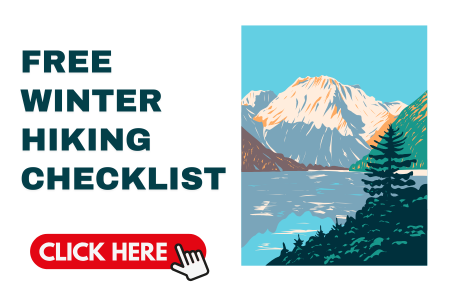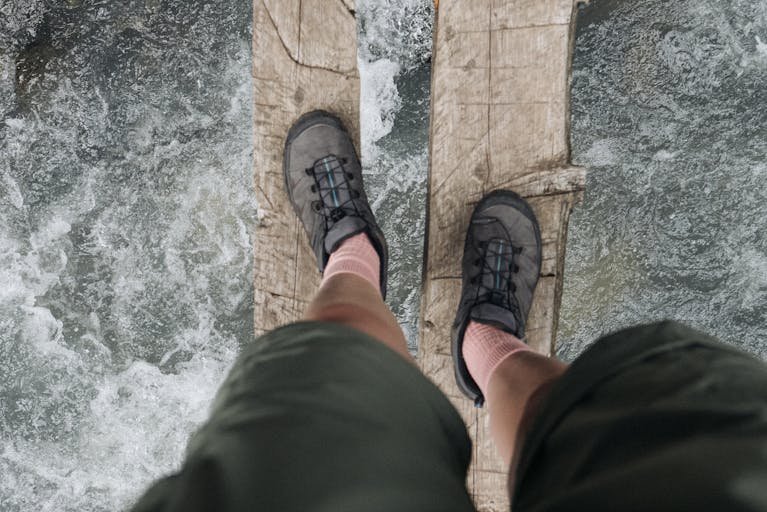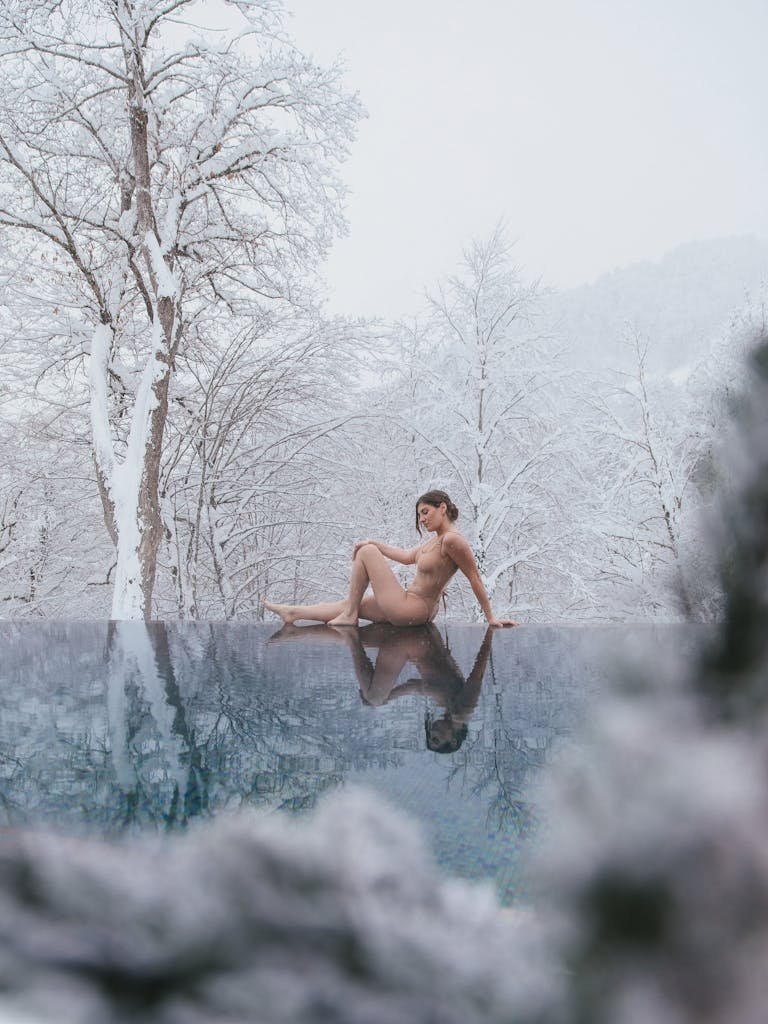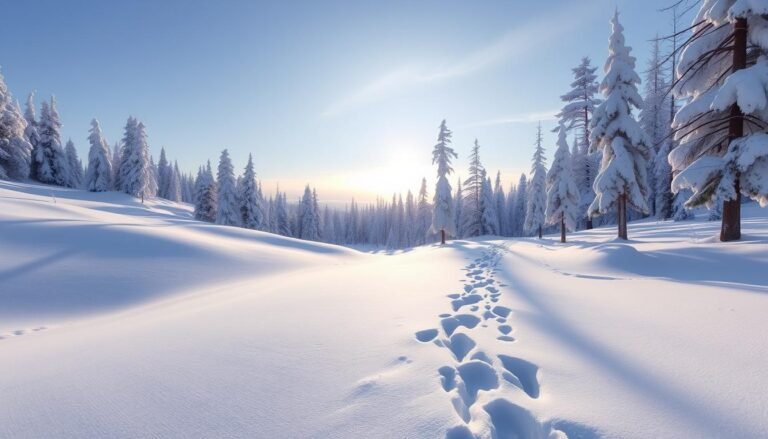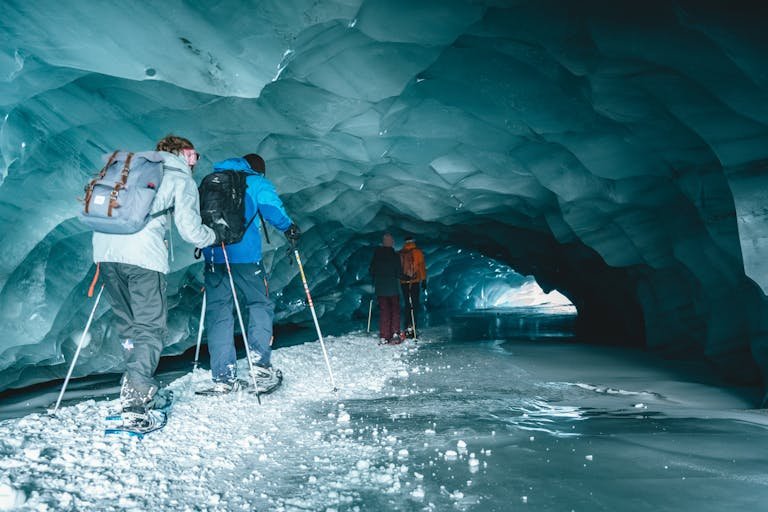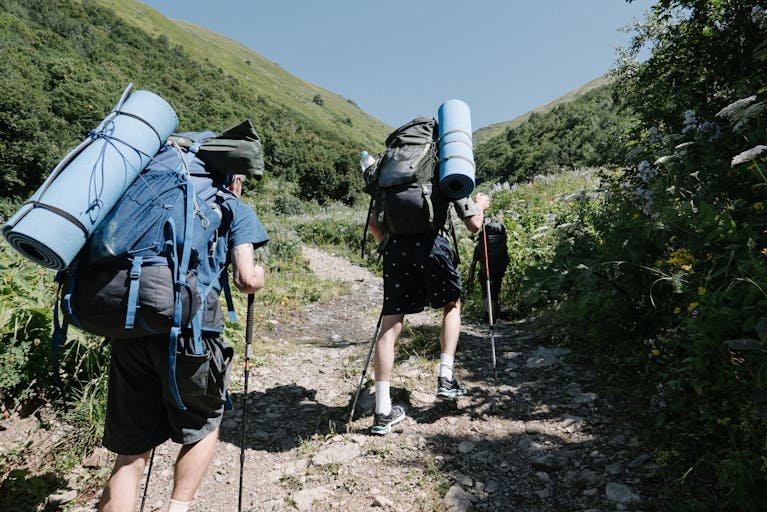Introduction
Winter holds a special kind of magic for outdoor enthusiasts. As the first snow blankets the landscape, familiar trails transform into serene, white wonderlands, inviting hikers to experience nature’s tranquility in a whole new light. The crisp air, the crunch of snow underfoot, and the breathtaking vistas offer a peaceful escape from the hustle and bustle of daily life. However, winter hiking also demands respect for the season’s challenges—harsh weather, icy paths, and shorter daylight hours require careful preparation and the right gear.
This Top Ten Best Winter Hikes in North America list celebrates the continent’s most spectacular winter trails, each offering unique experiences for hikers of all levels. From the rugged peaks of the Rockies to the iconic trails of national parks, these hikes are curated based on their beauty, accessibility, and the unforgettable adventures they promise. Whether you’re a seasoned hiker seeking new challenges or a beginner eager to explore snowy landscapes, these top ten trails provide the perfect blend of safety, excitement, and natural splendor.
Top Ten Best Winter Hikes in North America
Winter unveils a different side of North America’s natural beauty, making it an ideal time for hikers seeking tranquility and stunning vistas. Here are the top ten winter hikes that promise unforgettable experiences:
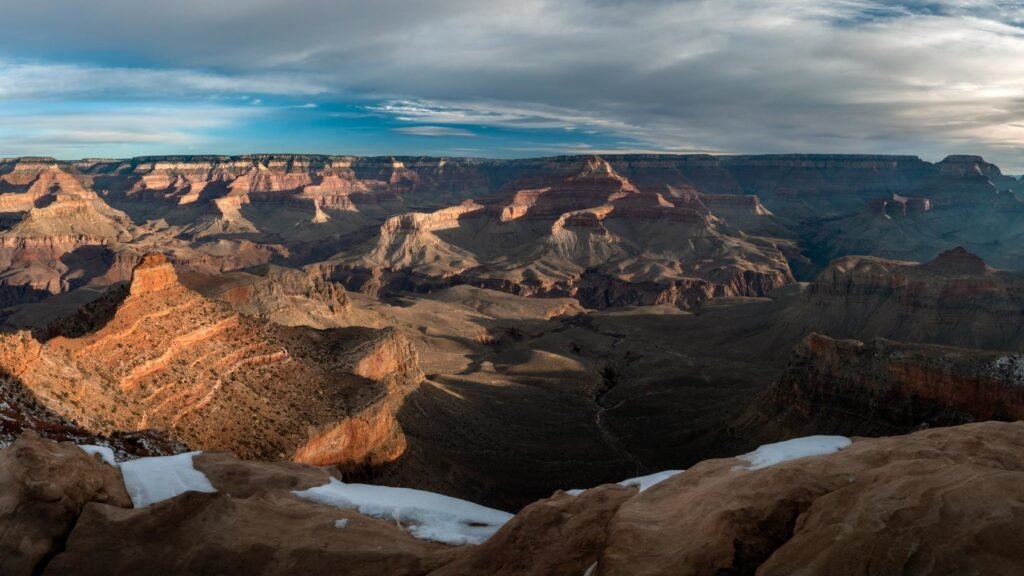
1. Grand Canyon South Kaibab Trail – Arizona, USA
Location: Grand Canyon National Park
Highlights: Panoramic winter views of the canyon, fewer crowds
History: Established in 1919, the South Kaibab Trail was one of the first trails in the Grand Canyon designed to provide easy access to the canyon’s interior. It has since become a favorite for those seeking stunning vistas and a challenging hike.
Description:
The South Kaibab Trail offers some of the most spectacular views of the Grand Canyon, especially enchanting in winter when the cooler temperatures provide comfortable hiking conditions. Snow dusting the canyon rims adds a magical touch to the already awe-inspiring scenery. The trail descends steeply into the canyon, offering panoramic vistas of the vast expanse below, making it a must-visit for winter hikers seeking solitude and breathtaking landscapes.
Tips:
- Start Early: Begin your hike at dawn to maximize daylight hours and enjoy the sunrise over the canyon. Early starts also help you avoid afternoon weather changes.
- Layer Up: Dress in multiple layers to adjust to temperature fluctuations, especially as you descend into the canyon where it can be significantly colder.
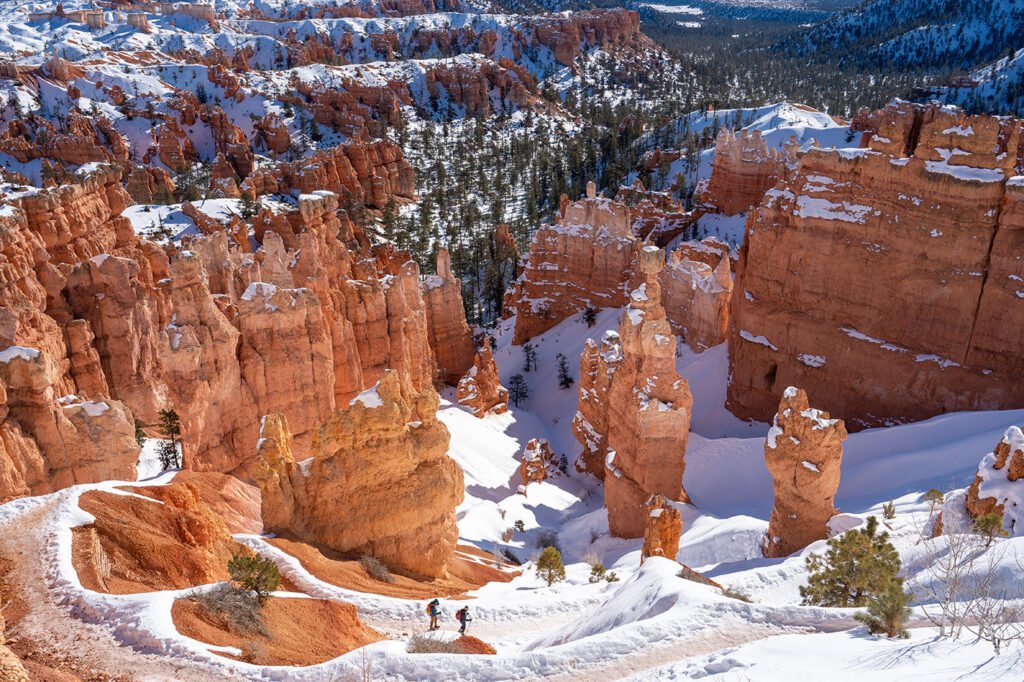
2. Bryce Canyon’s Navajo Loop Trail – Utah, USA
Location: Bryce Canyon National Park
Highlights: Iconic hoodoos covered in snow, dramatic landscapes
History: Bryce Canyon was named after Ebenezer Bryce, a Mormon pioneer who settled in the area in the 1870s. The Navajo Loop Trail, named in honor of the Navajo people, showcases the park’s unique geological formations.
Description:
This trail takes you through Bryce Canyon’s famous hoodoos and winding paths, offering a unique winter perspective of the park’s geological wonders. The contrast between the white snow and the red rock formations creates a striking visual experience. As you traverse the loop, you’ll encounter the iconic Thor’s Hammer and Wall Street, each offering picturesque views that are even more captivating when blanketed in snow.
Tips:
- Use Trekking Poles: Enhance your stability on icy sections and provide extra support when navigating steep or uneven terrain.
- Check for Trail Closures: Winter weather can lead to temporary trail closures. Always verify current trail conditions before setting out.
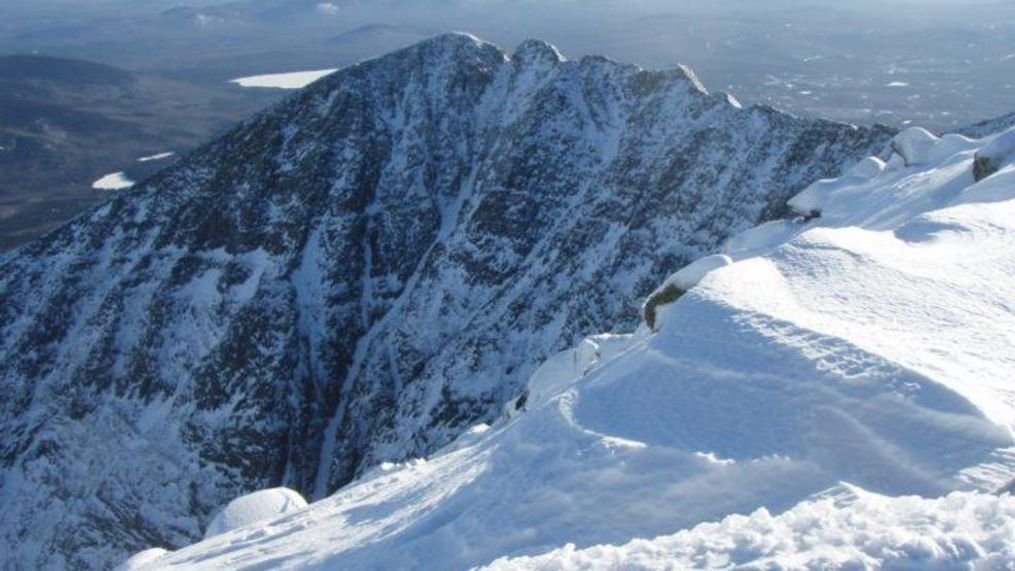
3. Mount Katahdin’s Knife Edge Trail – Maine, USA
Location: Baxter State Park
Highlights: Challenging ridge walk, stunning alpine views
History: Mount Katahdin, the highest peak in Maine, is named after the legendary Penobscot Indian chief, Katahdin. The Knife Edge Trail is one of the most challenging hikes in the Northeast, known for its narrow ridge and breathtaking views.
Description:
As Maine’s highest peak, Mount Katahdin presents a formidable winter challenge. The Knife Edge Trail is renowned for its narrow ridge and breathtaking views, making it a coveted hike for experienced winter adventurers seeking an adrenaline rush. The trail demands careful navigation and physical endurance, but the reward is unparalleled panoramic views of Baxter State Park and beyond.
Tips:
- Hire a Guide: Due to the trail’s difficulty and exposure, consider hiring a local guide to ensure safety and provide expert navigation.
- Equip Properly: Bring crampons and ice axes, and ensure you have experience using them in snowy and icy conditions.
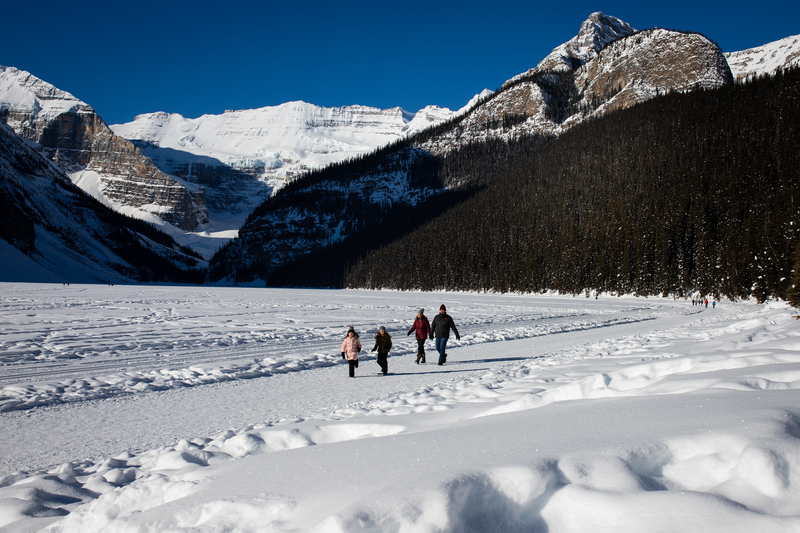
4. Lake Louise Lakeshore Trail – Alberta, Canada
Location: Banff National Park
Highlights: Frozen turquoise lakes, surrounding snow-capped peaks
History: Lake Louise was named after Princess Louise Caroline Alberta, the fourth daughter of Queen Victoria. The Lakeshore Trail has been a favorite among hikers for over a century, offering stunning views of the lake and surrounding mountains.
Description:
The Lakeshore Trail around Lake Louise is a picturesque winter hike that showcases the stunning beauty of the Canadian Rockies. The frozen lake and towering mountains create a serene and picturesque environment perfect for photography and peaceful trekking. The trail offers relatively gentle terrain, making it accessible for a wide range of hikers while still providing spectacular views.
Tips:
- Use Traction Devices: Equip your boots with microspikes or crampons to navigate icy patches safely.
- Photograph Early Morning: Capture the best light and enjoy fewer crowds by hiking early in the day.

5. Trail Ridge Road to Alpine Ridge – Colorado, USA
Location: Rocky Mountain National Park
Highlights: High-altitude views, diverse winter wildlife
History: Trail Ridge Road is the highest continuous paved road in the United States, built in the 1930s by the Civilian Conservation Corps. It provides access to numerous trails and offers some of the most stunning high-altitude views in North America.
Description:
Trail Ridge Road is one of the highest paved roads in North America, offering access to numerous winter hiking trails. The Alpine Ridge section provides expansive views of the Rockies, with opportunities to spot elk and other wildlife adapted to winter conditions. The trail’s high elevation ensures breathtaking vistas, but also requires hikers to be prepared for colder temperatures and potential altitude-related challenges.
Tips:
- Acclimate Gradually: Spend some time at high elevations before embarking on strenuous hikes to prevent altitude sickness.
- Stay Hydrated: High altitudes can lead to quicker dehydration. Carry ample water and drink regularly.
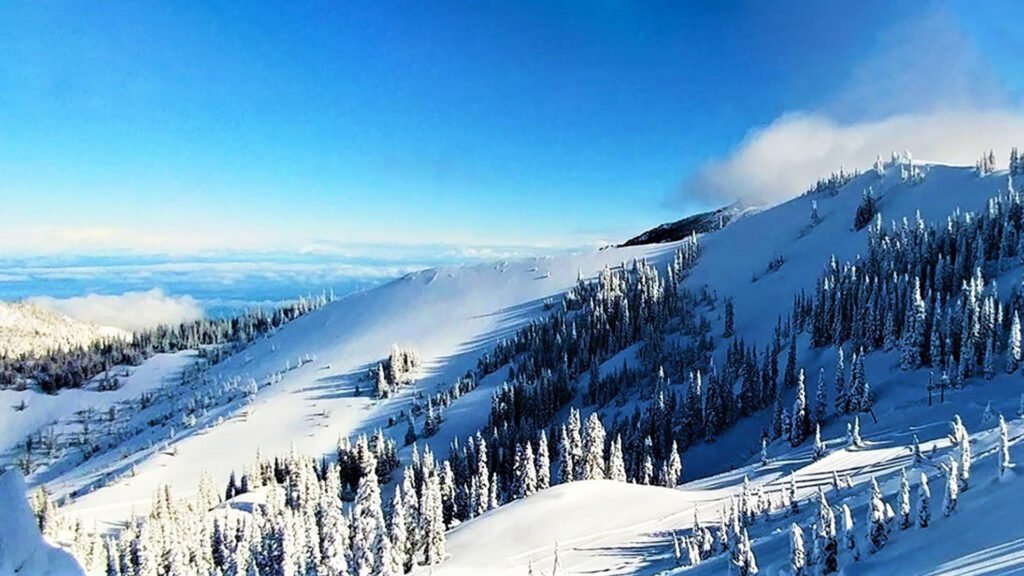
6. Olympic National Park’s Hurricane Ridge – Washington, USA
Location: Olympic National Park
Highlights: Panoramic mountain vistas, accessible winter trails
History: Hurricane Ridge was developed by the Civilian Conservation Corps in the 1930s as part of the Olympic National Park’s infrastructure. It has since become a popular destination for winter hikers and snow enthusiasts.
Description:
Hurricane Ridge offers some of the best winter hiking in the Pacific Northwest, with well-maintained trails that provide stunning views of the Olympic Mountains and the Strait of Juan de Fuca. The area is also known for its diverse wildlife and beautiful snow-covered forests. The accessibility of Hurricane Ridge makes it a favorite among both novice and experienced winter hikers.
Tips:
- Layer Appropriately: Wear multiple layers to adjust to changing temperatures and stay comfortable throughout your hike.
- Monitor Weather Closures: Winter storms can lead to sudden trail closures. Check current conditions before your hike.
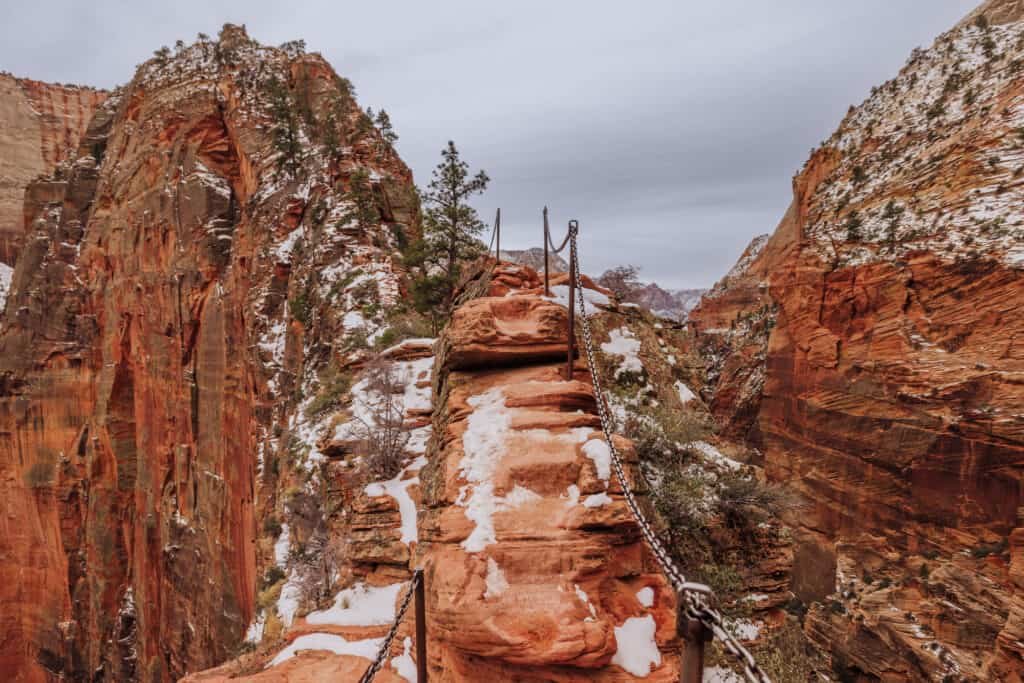
7. Zion National Park’s Angel’s Landing – Utah, USA
Location: Zion National Park
Highlights: Dramatic canyon views, thrilling trail segments
History: Angel’s Landing is one of Zion National Park’s most famous trails, originally used by Mormon settlers in the late 19th century. Its narrow ridges and steep ascents have made it a legendary hike for thrill-seekers.
Description:
While typically a summer destination, Angel’s Landing in Zion National Park transforms into a challenging winter hike. The cooler temperatures make the strenuous ascent more manageable, and the snow-capped cliffs add an extra layer of beauty to the iconic trail. The trail’s final ascent involves a narrow ridge with chains for support, offering exhilarating views of Zion Canyon.
Tips:
- Check for Ice and Snow: Conditions can vary greatly, making parts of the trail slippery. Use appropriate traction devices and tread carefully.
- Use Protective Gear: Wear gloves and consider using a helmet if conditions are icy or if you’re navigating rocky sections.

8. Acadia National Park’s Precipice Trail – Maine, USA
Location: Acadia National Park
Highlights: Steep climbs, coastal winter scenery
History: Acadia National Park was established in 1916 as one of the first national parks in the United States. The Precipice Trail, known for its iron rungs and ladders, has been a challenging route since the early 20th century.
Description:
The Precipice Trail is one of Acadia’s most exhilarating hikes, featuring iron rungs and ladders that lead to stunning coastal views. In winter, the trail offers a serene and less crowded experience, with the Atlantic Ocean providing a dramatic backdrop to your adventure. The combination of steep climbs and icy conditions makes it a thrilling choice for experienced winter hikers.
Tips:
- Use Traction Devices: Equip your boots with microspikes or crampons to navigate icy sections safely.
- Stay Alert: The trail is exposed and can be slippery; maintain focus and take your time on steep or icy parts.
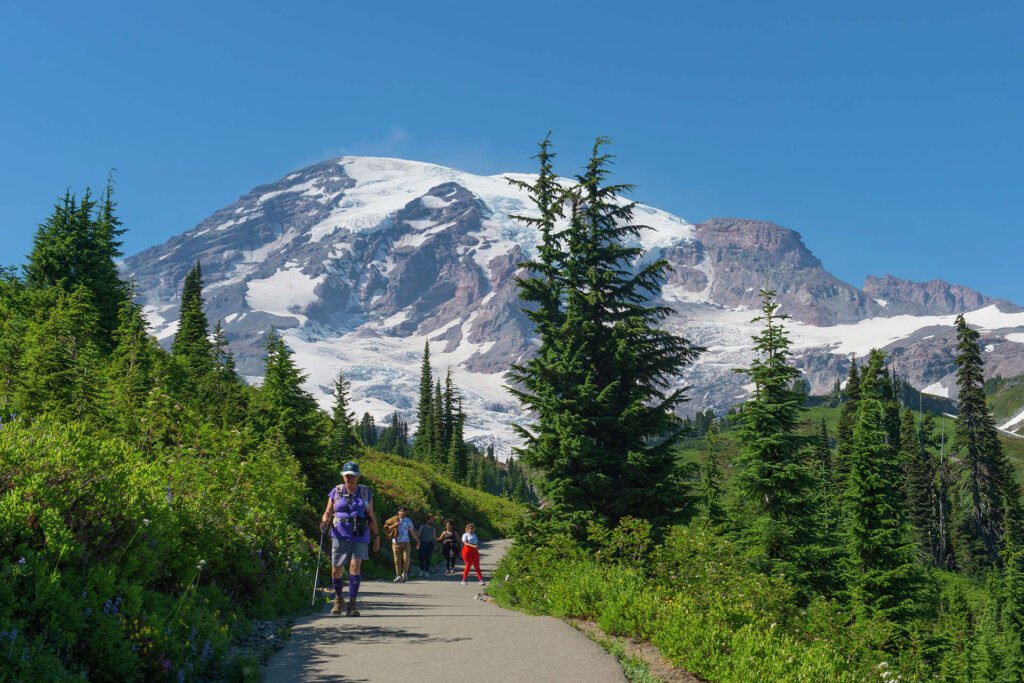
9. Mount Rainier’s Skyline Trail – Washington, USA
Location: Mount Rainier National Park
Highlights: Glacial vistas, alpine meadows
History: Mount Rainier, an active stratovolcano, has been a symbol of the Pacific Northwest since the early 20th century. The Skyline Trail, developed in the 1940s, offers some of the best views of the mountain’s glaciers and alpine landscapes.
Description:
The Skyline Trail around Mount Rainier is a premier winter hike that showcases the park’s majestic glaciers and alpine scenery. The trail offers a mix of challenging climbs and rewarding panoramic views, making it a favorite among winter hiking enthusiasts. Snow-covered meadows and frozen streams add to the trail’s beauty, providing ample opportunities for photography and wildlife observation.
Tips:
- Prepare for Extreme Cold: Temperatures can drop significantly; wear insulated layers and protect extremities from frostbite.
- Use Proper Gear: Crampons, ice axes, and traction devices are essential for navigating icy and snowy sections safely.
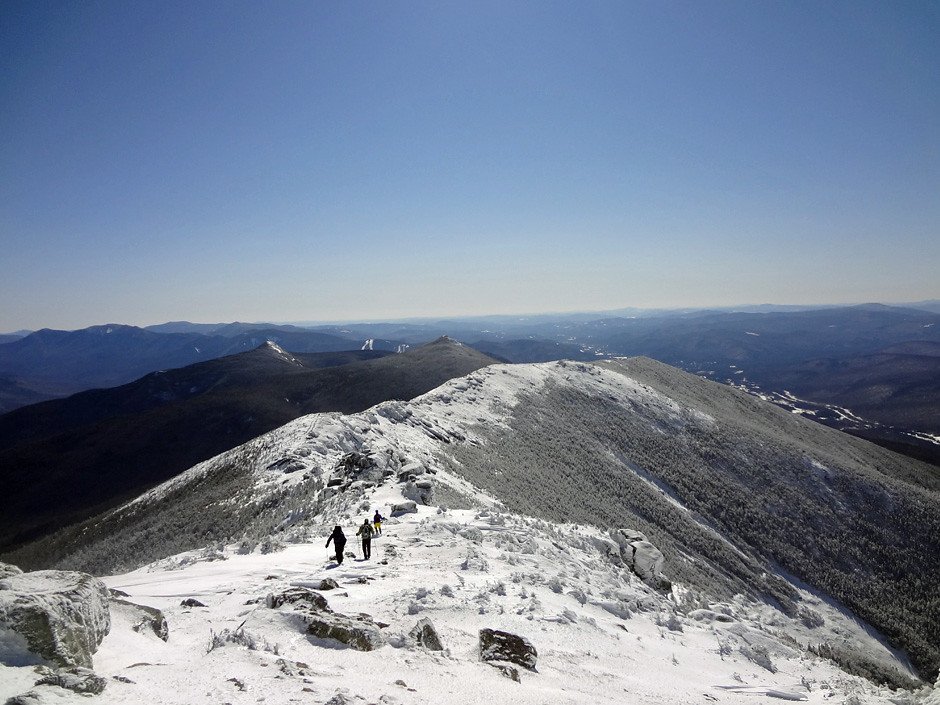
10. White Mountains’ Franconia Ridge Trail – New Hampshire, USA
Location: White Mountain National Forest
Highlights: Rugged ridge walks, expansive views
History: The Franconia Ridge Trail was developed in the early 20th century as part of the White Mountain National Forest’s trail system. It has since become a staple for hikers seeking challenging ridge walks and stunning panoramic views.
Description:
Franconia Ridge Trail is a quintessential winter hike in the White Mountains, offering a rigorous ridge walk with stunning vistas of snow-covered peaks and valleys. The trail is renowned for its dramatic scenery and the sense of accomplishment upon reaching the summit. The challenging terrain includes exposed ridges and icy ledges, making it a thrilling adventure for experienced winter hikers.
Tips:
- Navigate Carefully: Icy ledges and exposed sections require cautious footing. Use microspikes or crampons to enhance traction.
- Start Early: Ensure you have ample daylight to complete the hike safely, avoiding afternoon storms and darkness.
Tips for Winter Hiking
- Layer Your Clothing:
- Use the Layering System: Start with a moisture-wicking base layer to keep sweat away, add an insulating layer for warmth, and finish with a waterproof outer layer to protect against wind and snow.
- Adjust Layers as Needed: Remove or add layers based on your activity level and changing weather conditions to maintain a comfortable body temperature.
- Plan Your Route Carefully:
- Research the Trail: Understand the trail’s difficulty, length, elevation gain, and any specific winter hazards. Check official park websites for up-to-date trail conditions and closures.
- Map Your Path: Familiarize yourself with the trail map, noting key landmarks and potential exit points in case you need to turn back.
- Start Early:
- Maximize Daylight: Winter days are shorter, so starting early ensures you have enough daylight to complete your hike safely.
- Avoid Afternoon Weather: Weather can change rapidly in winter; starting early reduces the risk of encountering severe conditions later in the day.
- Stay Hydrated:
- Carry Insulated Containers: Prevent your water from freezing by using insulated bottles or hydration systems.
- Monitor Your Intake: Even in cold weather, your body needs hydration to function properly. Drink regularly to maintain energy levels and prevent dehydration.
- Pace Yourself:
- Manage Your Energy: Winter hiking can be more strenuous due to the cold and added resistance from snow. Take regular breaks to rest and refuel.
- Listen to Your Body: Pay attention to signs of fatigue or discomfort and adjust your pace accordingly to prevent overexertion.
- Check Weather Conditions:
- Stay Informed: Continuously monitor weather forecasts before and during your hike. Use reliable sources like national park websites or weather apps.
- Be Prepared to Adapt: If severe weather is approaching, be ready to alter your plans, seek shelter, or turn back to ensure your safety.
- Leave a Trip Plan:
- Inform Others: Let a trusted friend or family member know your hiking route, estimated start and finish times, and your expected return.
- Carry Communication Devices: Bring a fully charged smartphone, a satellite communicator, or a Personal Locator Beacon (PLB) for emergency situations.
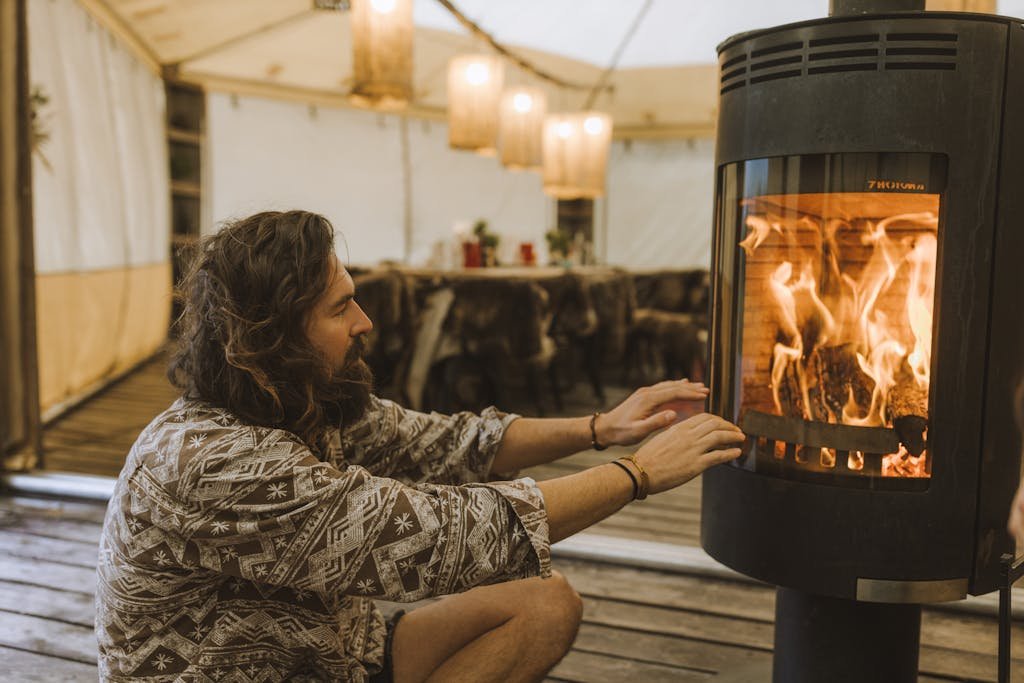
Safety Tips
- Understand Avalanche Risks:
- Educate Yourself: Learn about avalanche conditions, including snowpack stability and weather patterns that increase avalanche danger.
- Carry Safety Gear: If hiking in avalanche-prone areas, always carry a beacon, probe, and shovel, and know how to use them effectively.
- Stay on Marked Trails:
- Avoid Unmarked Paths: Venturing off established trails increases the risk of getting lost and encountering unexpected hazards.
- Follow Trail Markers: Pay attention to trail signs and markers to stay on the correct path and ensure you’re in a safe area.
- Be Prepared for Emergencies:
- Carry a First Aid Kit: Include essentials like bandages, antiseptics, pain relievers, and any personal medications.
- Know Basic First Aid: Familiarize yourself with basic first aid procedures to handle minor injuries until help arrives.
- Watch for Signs of Hypothermia and Frostbite:
- Recognize Symptoms: Be aware of signs such as excessive shivering, confusion, numbness, and pale or waxy skin.
- Act Immediately: If you suspect hypothermia or frostbite, seek shelter, warm the affected areas gradually, and seek medical help as soon as possible.
- Travel with a Companion:
- Increase Safety: Hiking with a partner enhances safety, as you can assist each other in case of injury or unexpected situations.
- Share Responsibilities: Split tasks such as navigation, gear management, and decision-making to ensure both hikers are engaged and aware.
- Keep Your Gear Accessible:
- Organize Your Backpack: Place essential items like navigation tools, fire starters, and first aid kits in easily reachable pockets.
- Avoid Overpacking: Carry only what you need to keep your backpack light and ensure quick access to critical gear.
- Avoid Overexertion:
- Manage Your Pace: Maintain a steady pace that allows you to conserve energy and prevent excessive sweating, which can lead to moisture accumulation and heat loss.
- Take Regular Breaks: Rest periodically to maintain energy levels and assess your condition, adjusting your hike as needed.
References and Resources
- Books:
- Winter Hiking: The Ultimate Guide to Staying Safe, Warm, and Enjoying the Snowy Trails by Ilona Slater
- The Complete Idiot’s Guide to Winter Hiking by Jason Stevenson
- Websites:
- Gear Retailers:
- Safety Courses:
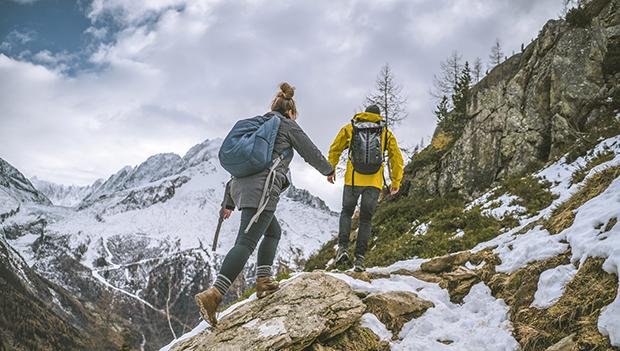
Beginners to Advanced Winter Hikers
Beginner Hikers
- Start with Short, Well-Marked Trails:
Choose trails that are less challenging and well-maintained to build confidence and experience in winter conditions. Familiarize yourself with basic winter hiking gear and techniques. - Essential Gear Focus:
Prioritize basic items like insulated footwear, layered clothing, navigation tools, and a first aid kit. Ensure your gear is suitable for the specific conditions you’ll encounter. - Learn Basic Skills:
Familiarize yourself with using a map and compass, basic first aid, and understanding weather patterns. These skills are crucial for navigating trails and handling unexpected situations. - Hike with Experienced Partners:
Joining hikes with more experienced hikers can provide valuable learning opportunities and added safety. Observing their techniques and strategies can enhance your own hiking practices.
Intermediate Hikers
- Explore Varied Terrains:
Gradually take on trails with moderate difficulty, including some elevation changes and varied snow conditions. This helps build endurance and adaptability to different winter environments. - Enhance Your Gear:
Incorporate items like trekking poles, hand warmers, and emergency shelters to improve comfort and preparedness. Upgrading your gear can make your hikes more enjoyable and safer. - Advanced Navigation Skills:
Utilize GPS devices and learn to read more complex maps, enhancing your ability to navigate in diverse conditions. Understanding advanced navigation techniques can prevent getting lost in challenging terrains. - Participate in Safety Courses:
Enroll in avalanche safety and winter survival courses to deepen your knowledge and skills. These courses provide essential training for handling emergencies and understanding winter hazards.
Advanced Hikers
- Tackle Challenging Trails:
Venture into more demanding terrains such as alpine regions, backcountry areas, and avalanche-prone zones. These areas offer greater rewards but require higher skill levels and preparation. - Specialized Equipment:
Use advanced gear like crampons, ice axes, and avalanche beacons, ensuring proficiency in their use. Mastering this equipment is essential for navigating technical and hazardous trails safely. - Longer Expeditions:
Plan for multi-day hikes, incorporating strategies for overnighting, extended navigation, and self-sufficiency. Longer expeditions demand thorough planning and reliable gear to ensure success. - Leadership and Rescue Skills:
Develop skills in leading groups, performing rescues, and managing complex emergencies effectively. Leadership abilities enhance your capacity to assist others and handle high-stress scenarios.
Alternative Winter Hikes: 20 Worthy Trails
While our top ten list features some of the most iconic winter hikes, North America is home to countless other trails that offer unique and rewarding experiences. Here’s a table of 20 Best-Known Alternative Winter Hikes that didn’t make the top ten but are still worthy of your consideration:
| Trail Name | Location | Difficulty | Description | Link |
|---|---|---|---|---|
| 1. The Highline Trail | Glacier National Park, Montana, USA | Moderate | A scenic trail offering views of glaciers, alpine meadows, and snow-covered peaks. Ideal for intermediate hikers seeking beautiful winter landscapes. | Glacier National Park |
| 2. The Wonderland Trail | Mount Rainier National Park, Washington, USA | Advanced | A challenging loop trail encircling Mount Rainier, offering diverse winter scenery including glaciers and dense forests. | Mount Rainier National Park |
| 3. Cathedral Peak Trail | Lake Tahoe, California, USA | Moderate | A popular trail with stunning views of Lake Tahoe and surrounding snow-draped mountains, suitable for hikers with some winter experience. | Lake Tahoe |
| 4. Cascade Pass Trail | North Cascades National Park, Washington, USA | Moderate to Advanced | Offers breathtaking views of rugged peaks and glaciers, with variable snow conditions requiring careful preparation. | North Cascades National Park |
| 5. The Long Trail | Vermont, USA | Advanced | Stretching over 270 miles, select sections of The Long Trail provide excellent winter hiking opportunities for experienced adventurers. | The Long Trail |
| 6. Rattlesnake Ledge Trail | Washington, USA | Easy to Moderate | A shorter trail with rewarding views of Rattlesnake Lake and surrounding mountains, perfect for beginners and families. | Rattlesnake Ledge |
| 7. Skyline Trail to Burroughs Mountain | Mount Hood National Forest, Oregon, USA | Moderate | Offers panoramic views of Mount Hood and surrounding wilderness, with well-marked paths suitable for various skill levels. | Mount Hood National Forest |
| 8. Tahquitz Canyon Trail | Idyllwild, California, USA | Moderate | A scenic trail featuring waterfalls, deep canyons, and winter flora, ideal for hikers seeking diverse winter environments. | Tahquitz Canyon |
| 9. Hanging Lake Trail | Glenwood Canyon, Colorado, USA | Moderate | Known for its beautiful frozen lake and waterfalls in winter, this trail is a favorite for photographers and nature lovers. | Glenwood Canyon |
| 10. Hidden Lake Trail | Olympic National Park, Washington, USA | Moderate | A picturesque trail leading to a stunning frozen lake, surrounded by snow-covered forests and mountain views. | Olympic National Park |
| 11. Hanging Lake Trail | Colorado, USA | Moderate | A scenic trail leading to a frozen lake and waterfalls, perfect for winter photography and nature appreciation. | Glenwood Canyon |
| 12. Emerald Lake Trail | Rocky Mountain National Park, Colorado, USA | Moderate | Offers stunning views of emerald-colored lakes surrounded by snow-capped mountains, suitable for intermediate hikers. | Rocky Mountain National Park |
| 13. Maroon Bells Scenic Loop | Aspen, Colorado, USA | Easy to Moderate | A beautiful loop trail around the Maroon Bells, offering breathtaking winter views and accessible paths for various skill levels. | Maroon Bells |
| 14. Mount Marcy Trail | Adirondack Mountains, New York, USA | Advanced | The highest peak in New York, offering a challenging winter hike with rewarding views of the Adirondacks. | Adirondack Park |
| 15. Tahawus Mountain Trail | New York, USA | Moderate | A less crowded trail offering serene winter landscapes and panoramic views from the summit. | Tahawus Mountain |
| 16. Pinnacle Peak Trail | San Antonio, Texas, USA | Moderate | A trail that offers stunning views of the Texas Hill Country, transformed beautifully by winter snowfall. | Pinnacle Peak |
| 17. Half Dome Trail (Winter Section) | Yosemite National Park, California, USA | Advanced | Certain sections of the iconic Half Dome Trail offer unique winter hiking experiences with snow-covered landscapes. | Yosemite National Park |
| 18. Glacier Trail | Glacier National Park, Montana, USA | Advanced | A challenging trail that showcases glaciers and frozen waterfalls, perfect for experienced winter hikers. | Glacier National Park |
| 19. Mount Baker Ridge Trail | Mount Baker-Snoqualmie National Forest, Washington, USA | Moderate | Offers stunning winter views of Mount Baker and surrounding wilderness, with varied terrain suitable for different skill levels. | Mount Baker-Snoqualmie National Forest |
| 20. Black Forest Trail | Black Forest, Colorado, USA | Moderate | A picturesque trail through dense forests and open meadows, offering a peaceful winter hiking experience. | Black Forest |
Final Thoughts
Winter hiking offers an unparalleled opportunity to experience nature’s beauty in its most serene and pristine form. By choosing the right trails and being well-prepared, you can safely enjoy the tranquility and stunning landscapes that winter brings. Whether you’re just starting or seeking to push your limits, these top ten winter hikes in North America provide unforgettable adventures and lasting memories. Equip yourself with the essential gear, heed safety tips, and embrace the winter wilderness with confidence and enthusiasm. Happy hiking!

